By the time this article goes up, the entirety of Dark Ascension will be revealed on DailyMTG, but as of this writing, there’s a lot left to be revealed. Next week, we’ll take a break from world building to take a look at some of the interesting decisions made for the second set of Innistrad block, but for now, let’s continue to explore ways to find a world for a Magic expansion. Last week, we began our world building adventure by trying to fit Magic into existing settings, but as I noted in my first article here on Gathering Magic, most of these settings are extensions of particular stories, and thus aren’t equipped to house a Magic block. More general settings are, however, moldable.
Great Designer Search 2 II: Return of the Return of the Great Designer Search
I’d done a bit of independent Magic design before, but the second Great Designer Search was what really lit my fire. Watching the finalists, I got to see worlds developed from basic principles into functional partial sets, and I learned a lot from the contestants’ successes and failures. Of course, as Wizards was trying to find an intern, they eliminated finalists along the way. So the audience didn’t get to see everything come to fruition.
Scott Van Essen, Ethan Fleischer, and Shawn Main covered the tropes of a prison, a prehistoric world, and an apocalypse in far greater depth than I could hope to in a single column, and Jonathan Loucks got almost as much out of an underground setting. Jay Treat’s exploration of Muraganda and Devon Rule’s Utopia hit fewer tropes and were more akin to Magic settings of years gone by—like Onslaught and Odyssey’s Otaria. Nevertheless, I’d contend that Daniel Williams’s world concept was in and of itself the most compelling of these settings, and armed now with knowledge I’ve gained from the contest and having read the thoughts of my fellow design enthusiasts, I’m going to give Deadsands another shot.
Three Paces
In my mind, the make-it-or-break-it aspect of this Wild West backdrop is the showdown mechanic. Daniel went through a few iterations, each with its own issues, but at its core, the mechanic was always about mimicking the tense buildup and subsequent rapid release of -gunspellslinging. After innumerable iterations in the Wizards Community Forums, he entered the first challenge with:
As the good folks at Wizards pointed out, this mechanic ends up with both players fanning out their hands a lot, and thus takes the mystery out of things. More problematic than that, it encourages players to keep the cards they draw in hand, so the rest of the game doesn’t progress, and no draw feels exciting.
Daniel took that feedback to heart and came back with a whole new implementation for the next challenge:
On top of the cute “draw, fire” cue, this iteration solved the problems of having a repeat winner and revealing information, and it took great steps toward reducing card hoarding. Unfortunately, it brought a new major issue to the table: It punished players for using it. Most potential upsides for winning a showdown simply weren’t going to justify throwing away your (presumably) best cards, and in R&D’s playtesting, somebody would often win all of the showdowns and subsequently lose the actual game to mana flood.
While Daniel’s final submission prior to elimination didn’t contain any showdowns, he did share his final iteration of the mechanic:
Mark Gottlieb points out that this version doesn’t feel like a showdown because it will be on a spell, so you’ll usually win 1–0. In addition to that, it shares a smaller subset of each previous version’s issues. While this setup doesn’t reveal too much information, it still encourages hoarding spells to ensure you can outcast your opponent, and even though it lets you cast your spells, you’re less likely to use them to maximum effect while trying to play them all in a single turn.
None of this is meant to be a critique of Daniel’s abilities. Most of these are subtle issues, and many are undetectable with inadequate playtesting. That said, in thinking more about how to capture the essence of a showdown, I’ve come up with a couple of new options.
Showdown IV
My first attempt is a simple tweak of Daniel’s second pass:
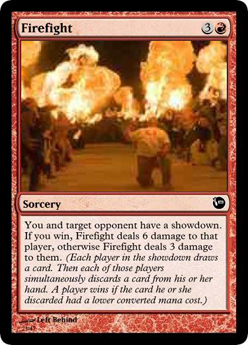
Going for lowest converted mana cost solves the most pressing issue with Daniel’s version. In the late-game, you desperately need spells, but ensuring that you’ll have enough lands early on usually means you end up with a lot of leftover lands in the late-game. Trying to win showdowns with this version of the mechanic should actually help you win rather than being a negative. Then again, this improvement comes with more than a few costs.
Perhaps the biggest issue with this implementation is how often it leads to a draw. While the top ends of decks’ curves tend to vary, every deck is full of lands, and the showdowns become a lot less dynamic when the caster realizes that he’s just trying to predict whether or not his opponent has a land in hand. Another potential problem stems from the fact that mana flood is usually only a late-game factor. We wouldn’t want to print early-game spells with this mechanic because making players want to mana screw themselves would be just as bad as making them throw away their spells.
Unfortunately, we can’t solve these problems by inserting the word “nonland” into the text; doing so would require revealing hands as verification, at which point we’re just back to the initial proposition. Despite these issues, I’d like to test this version of showdown at least once before throwing it by the wayside. If the draws come up less often than I think they would, it could be feasible.
Showdown V
Luckily for this hypothetical set, I also had an idea for a showdown mechanic slightly farther afield:
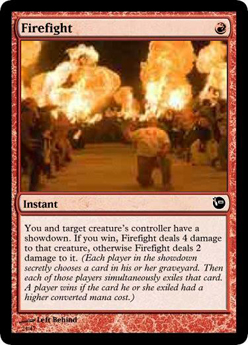
Though it isn’t perfect, this version solves our previous problem with showdown. The mechanic isn’t competing for resources that were already relevant, so trying to win showdowns won’t contribute to a player losing the game. The ultimate determinant, though, is whether we can work around this mechanic’s issues.
The showdown feels less dynamic because the information is public.
The most obvious workaround is to give players ways to put cards in their graveyards in response to a showdown-inducing spell. Here, we can take a page out of Innistrad’s book by including self-milling, creature sacrifice, and graveyard removal as methods of manipulation.
 |
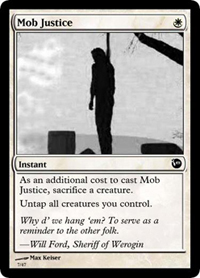 |
 |
These options take advantage of the library and battlefield as storehouses of cards, and we could easily take advantage of the hand in the same ways Odyssey did, but I think the showdowns will prove more exciting if your opponent doesn’t know that you can discard something in response to his spell. The obvious option is one of modern Magic’s taboos: instant discard.
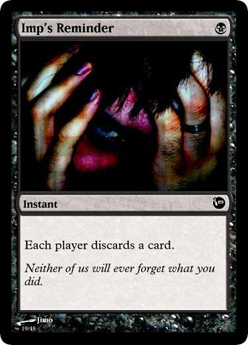
Why do we so rarely see instant-speed hand disruption? The main reason is that it makes games feel hopeless when your opponent can strip cards from your hand right after you draw them. While a designer could deal with this with some obscure clause like, “You can’t cast CARDNAME unless an opponent has cast a spell this turn,” my first inclination was to solve the problem by making the cards in question very weak.
Unfortunately, that option doesn’t solve the issue at hand. To see why, let’s take a quick look at land destruction. For the past few years, Wizards has been printing very weak land destruction spells because the vast majority of players don’t enjoy gameplay of those spells, and by making the spells weak, very few people will play them. In the last two sets, Magic 2012 and Innistrad, we’ve gotten uncommon land destruction effects that are Limited-playable in Tectonic Rift and Into the Maw of Hell. Neither card is good as land destruction, but their other effects lead players to include them, and then the land-destruction bit comes into play. That’s fine because land destruction becomes irrelevant as the game progresses. Instant-speed discard does not, and printing it in an environment where it’s playable just means that some of the original, unwanted gameplay will come up. But all is not lost—Deadsands still needs a returning mechanic, and with the shift to our latest version of showdown, it needs a Limited-smoothing mechanic like scry or kicker.
Cycling

Aside from being among the cleanest mechanics of all time, cycling does a lot for this particular set design. As mentioned, it enables instant-speed interaction with showdown and smooths Limited play, but it also gives players a way to put high-mana-costs into their graveyards early in the game and helps solve the biggest problem with showdown’s predictability.
Even with all of this instant-speed interaction, the actual showdown is predictable. Nobody’s going to be on the edge of his seat after the cards are secretly chosen. Unless, that is, we turn it into a game of Liar’s Dice. The first—and most important—step toward engendering that sort of gameplay is to fill the Limited environment with a lot of showdowns. With just a few, a player should probably exile his highest-costed card if it costs more than any of his opponent’s. But if showdowns occur every few turns, he might be better off holding onto his highest cost for a more important showdown under the assumption that his opponent knows he’s going to lose and will thus throw away a low-cost card. If the player without the highest card tries to win, he might just steal showdowns out from under his better-prepared opponents’ noses.
Instant-speed interaction adds a whole new level to this gameplay. If your opponent ditches a card with a high casting cost in response to your showdown spell, surely he’s going to exile it to win the showdown . . . unless he’s trying to intimidate you so that he can use up a lower-cost card. I’m not sure what density of showdown is necessary to elicit this sort of interaction, but showdown is such a complex mechanic that if it’s going to exist at common, it had better get enough of a spotlight to be worth learning.
Showdown is Complex
Take another look at the current implementation of showdown:

In addition to having its own execution process, this mechanic requires players to keep track of cards in both graveyards. Thankfully, graveyard ordering effects are gone, so in every format more restrictive than Legacy, players can sort their ’yards from highest to lowest converted mana cost. Still, this complexity means that I’d be uncomfortable printing a repeatable showdown effect at any rarity. On top of that, it’s just plain wordy. That, at least, we can improve on. While having a showdown occur between two players is flavorful, I don’t think having a Mexican standoff is enough worse to warrant all of the extra text a duel needs.
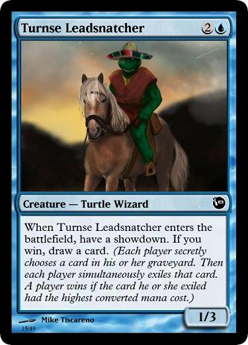
This is still pretty wordy, but it’s a lot easier to parse, and ultimately, that’s a lot more important than shaving a line of text.
The Rest of the West
With the start of a mechanical identity in place, I’d start to design around old West tropes to see if another new mechanic emerged naturally, but I’m running pretty long this week as it is. Next week, I’ll be doing some analysis of Dark Ascension, but please let me know what you’d like to see the week after. Do you want to continue on this Western adventure, take a look at a different environment-driven design, or move on to the next method in our world-building toolkit? Let me know in the comments, and we’ll see what we can do.
Jules Robins
julesdrobins at gmail dot com






















